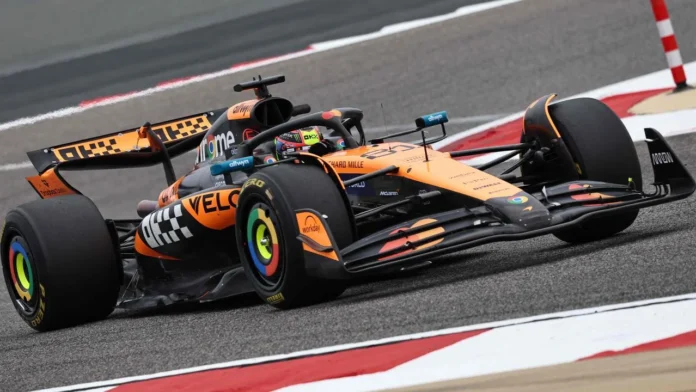Introduction
Formula 1 has officially returned, with the pre-season test in Bahrain marking the beginning of the 2025 season. During this crucial F1 testing phase, all 10 teams and 20 drivers take to the track to fine-tune their cars ahead of the first race in Melbourne.
While pre-season testing is primarily about preparation, keen-eyed fans may notice some peculiar innovations on display—most notably, the use of flow-vis paint and aero rakes. These tools, though visually unusual, play a significant role in gathering critical aerodynamic data that shapes each team’s strategy. Without these advanced methods, teams would struggle to assess how air moves across their cars, limiting their ability to make necessary refinements before the first race.
What Is Flow-Vis Paint and Why Is It Used?
One of the simplest yet most effective tools in an F1 team’s arsenal is flow-vis paint. This bright, oil-based paint helps engineers visualize how air flows over different parts of the car. When applied to a surface, the movement of the car spreads the paint, allowing teams to analyze its drying patterns.
Former Ferrari and Williams engineer Rob Smedley once explained that flow-vis paint helps aerodynamicists detect areas where airflow separates or becomes turbulent. Identifying such inefficiencies enables teams to make real-time adjustments, refining their aerodynamics for better performance. By comparing real-world data with wind tunnel simulations and computational fluid dynamics (CFD) models, engineers can identify discrepancies and make targeted improvements.

Flow-vis paint is particularly useful in high-speed corners and straight-line runs, where air stability is crucial. If airflow is found to be inconsistent in key areas, teams can tweak bodywork elements, such as front and rear wings, bargeboards, and floor edges, to optimize their aerodynamic package. This process allows teams to maximize downforce while reducing drag, ensuring better handling and improved straight-line speed.
The Role of Aero Rakes in Testing
Another prominent feature during pre-season testing is the aero rake—a scaffolding-like structure covered in sensors. These rakes are strategically attached to the car to measure the airflow around it, transmitting real-time data back to the team.
Teams frequently use aero rakes in different configurations to test how various aerodynamic setups affect car performance. Some are large and easily noticeable, extending from the car’s side, while others are smaller and placed near the front and rear axles. The information collected helps engineers fine-tune the car’s design before the competitive season begins.
Aero rakes are equipped with multiple pressure sensors that create a three-dimensional map of airflow distribution. This data is essential for validating wind tunnel and CFD predictions, helping teams detect unexpected aerodynamic behaviors. Engineers can then adjust elements such as wing angles, underfloor designs, and cooling ducts to enhance efficiency.
One of the critical aspects of using aero rakes is determining vortex structures—swirling patterns of air that affect car stability. Understanding these structures allows teams to refine the design of aerodynamic surfaces to ensure consistent and predictable airflow. Without aero rakes, teams would be forced to rely solely on wind tunnel data, which may not always align with real-world track conditions.

Other Key Terms in Pre-Season Testing
Beyond flow-vis paint and aero rakes, several other terms frequently arise during F1 testing:
- Sandbagging: When a team deliberately hides its true pace by running a heavier fuel load or using a less-powerful engine mode. This tactic prevents rival teams from accurately assessing their performance level.
- Glory Run: The opposite of sandbagging, where a driver pushes for the fastest possible lap time, often creating misleading performance expectations. These runs can be used to attract sponsors or boost team morale.
- Installation Lap: A slow lap conducted at the start of a session to verify that key components, such as the brakes and throttle, are functioning correctly.
- Tyre Degradation Testing: Teams analyze how quickly different tyre compounds wear down under various track conditions, allowing them to make strategic choices during races.
- DRS Effectiveness: Testing how well the Drag Reduction System (DRS) performs in different aerodynamic configurations, ensuring optimal use during overtakes.
What’s Next for the Teams?
With two more days of testing ahead, teams will continue gathering data before heading back to their factories to refine their setups. Engineers will analyze every detail from the test sessions, making final adjustments to optimize performance before the season opener.
The 2025 Formula 1 season officially kicks off with the Australian Grand Prix from March 14-16 in Melbourne. By then, teams will have implemented all necessary changes based on the insights gained from flow-vis paint, aero rakes, and other testing methods.
As teams finalize their preparations, the insights gained from these aerodynamic tools will be instrumental in determining their early-season competitiveness. Fans can expect a thrilling start as the battle for supremacy begins on the track, with each team eager to demonstrate the effectiveness of their off-season development work.


